A recent report found that managing cloud costs, alongside resource usage, is the most pressing cloud management challenge for the fifth straight year. This makes sense, considering respondents said a staggering 32% of their cloud budget went to waste in 2022 alone.
It doesn’t end there. The following FinOps statistics also demonstrate the value of the cloud for many organizations.
Using these findings, you can discover what your competition is doing right, so you don’t have to waste time and money on trial and error. If that’s something you want, then dive right in.
Table Of Contents
- What Is FinOps?
- Why Is FinOps Important?
- Statistics On The Need For FinOps Today
- FinOps Adoption And Growth Statistics
- Statistics On Immediate FinOps Priorities For Practitioners
- Stats On Measuring Cloud ROI
- Latest Statistics On FinOps Challenges
- Statistics On FinOps Tools And Technologies
- What’s The Future Of FinOps And Current Trends
What Is FinOps?
In cloud computing, FinOps is short for Cloud Financial Operations. FinOps is the practice of maximizing the Return on Investment (ROI) of your cloud investment.
It does this as a part of cloud financial management. The FinOps discipline focuses on understanding, controlling, and optimizing cloud costs in an organization’s day-to-day operations.
FinOps is to finance what DevOps is to engineering. It is a fairly new approach to bringing together engineering and finance to manage cloud financials and enable their organizations to get the most value out of cloud investments.
Check out our snackable guide to FinOps here for more details.
You can also learn how to implement a FinOps program in the cloud for your organization, including best practices and the top FinOps tools to help you.
Why Is FinOps Important?
A common misconception about FinOps is that it is primarily focused on reducing cloud spending CloudZero. But that isn’t the only reason.
FinOps has more benefits, including:
- As cloud computing infrastructure becomes increasingly complex and expensive, FinOps provides a framework for visualizing, managing, and optimizing cloud costs.
- By seeking to understand cloud spend, FinOps enables better cloud cost visibility, such as measuring unit costs, splitting shared costs, and capturing costs of untagged resources.
- It emphasizes cloud financial accountability, aligning finance and engineering interests, so they can get the most business value out of the cloud.
- Tracking FinOps KPIs brings together people, processes, products, and platforms to optimize cloud resource usage and promote efficiency.
- Practicing FinOps helps optimize cloud costs, enabling organizations to invest in other business areas with freed-up resources.
- FinOps enables organizations to make informed decisions about their cloud investments by providing the data and insights they need.
Overall, FinOps is an important tool for you if you want to maximize the benefits of cloud computing. With accurate and actionable cloud cost intelligence at your fingertips, you can more accurately manage tradeoffs between cost, performance, and speed in the cloud.
So, let’s take a look at some fascinating FinOps statistics you need to know right now.
Statistics On The Need For FinOps Today
The following statistics make a solid business case for implementing FinOps in your organization.
1. 60% of professionals say their cloud bill is a little higher than it should be or way too high (source: CloudZero)
CloudZero’s State of Cloud Cost Intelligence report is a must-read for FinOps, engineering, and finance teams that want to transform their FinOps program.
- Only 13% of companies have allocated 75% of their cloud costs. Eighty-seven percent are not sure who is responsible for what costs and why.
- According to 73% of respondents, cloud costs concern the board or C-suite.
- Cost variances (cost anomalies such as spikes) can take a week or more to discover
Here’s something else. Only about 30% of respondents could tell where their cloud spending went, such as to a particular product, department, or customer. It’s worse for larger SaaS companies:
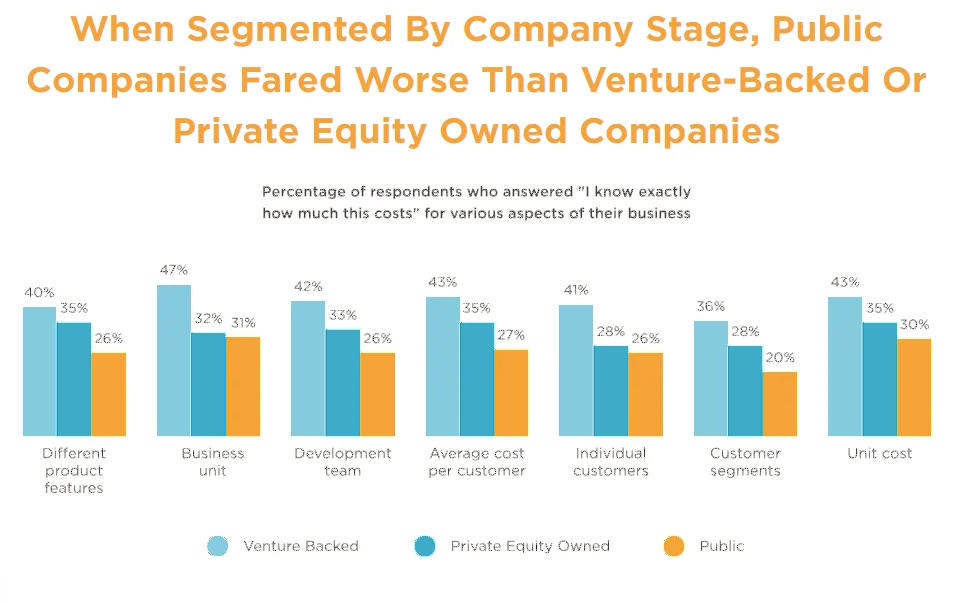
2. One in two business leaders say challenges with measuring the value of the cloud prevent them from achieving cloud ROI (source: PwC)
Nearly half of CFOs in a PwC survey said they were confident in their ability to measure ROI on cloud services.
In our view, this is yet another cloud cost visibility issue, since if you know who, what, why, and how you spend your cloud budget, it becomes much easier to tell whether you are getting the most out of your investment.
A robust cloud FinOps tool like CloudZero can help you identify which processes, teams, and products consume the most cloud resources. You can then compare each one’s costs vs returns to determine where to invest, what tradeoffs to make, and where to cut spending in favor of the best-performing areas.
3. Cloud technologies will account for 65% of all enterprise application spending by 2025 (source: Gartner)
Gartner predicts that cloud spending will outpace IT spending by 2025 as organizations move part or all of their operations to the cloud. The majority of cloud spending will be on public clouds. Consider this:
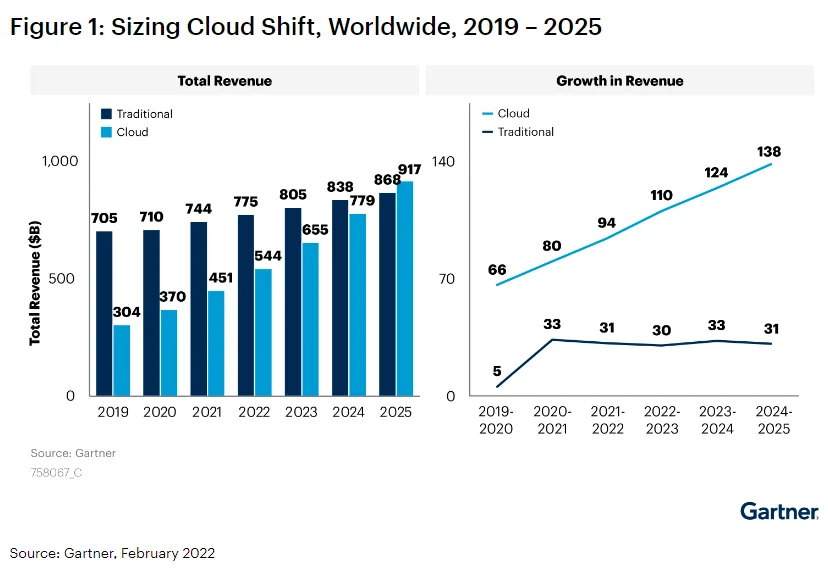
Credit: Gartner Cloud Shift Survey 2022
4. 89% view FinOps as the way to reign in cloud cost complexity (source: CloudBolt)
Wakefield Research reported in June 2023 that nearly 3 out of 10 of developers, engineers, and C-Suite are prioritizing FinOps this year. Seventy-four percent said FinOps is now as important to them as other common IT disciplines, such as DevOps and SecOps.
In fact, 355 of the 500 who responded said achieving their 2023 IT goals without practicing FinOps would pose a significant challenge. That makes sense. After all, most practitioners want to promote innovation without breaking the bank, which FinOps can support.
5. A third of cloud budgets goes to waste (source: Flexera)
Today, cloud waste is even worse than it ever has been, which emphasizes the need to practice FinOps even more.
The 2022 findings also showed that companies tend to overspend on cloud services by 13% on average. The respondents also self-reported that they waste about 32% of their cloud spend and think they spend 68% of it “efficiently”.
6. Over half of enterprises are struggling to see cloud ROI (source: PwC)
Optimizing the value of the cloud to an organization is a key part of FinOps. And there’s a dire need for it considering 53% of enterprises were yet to see “substantial value” from their cloud investments.
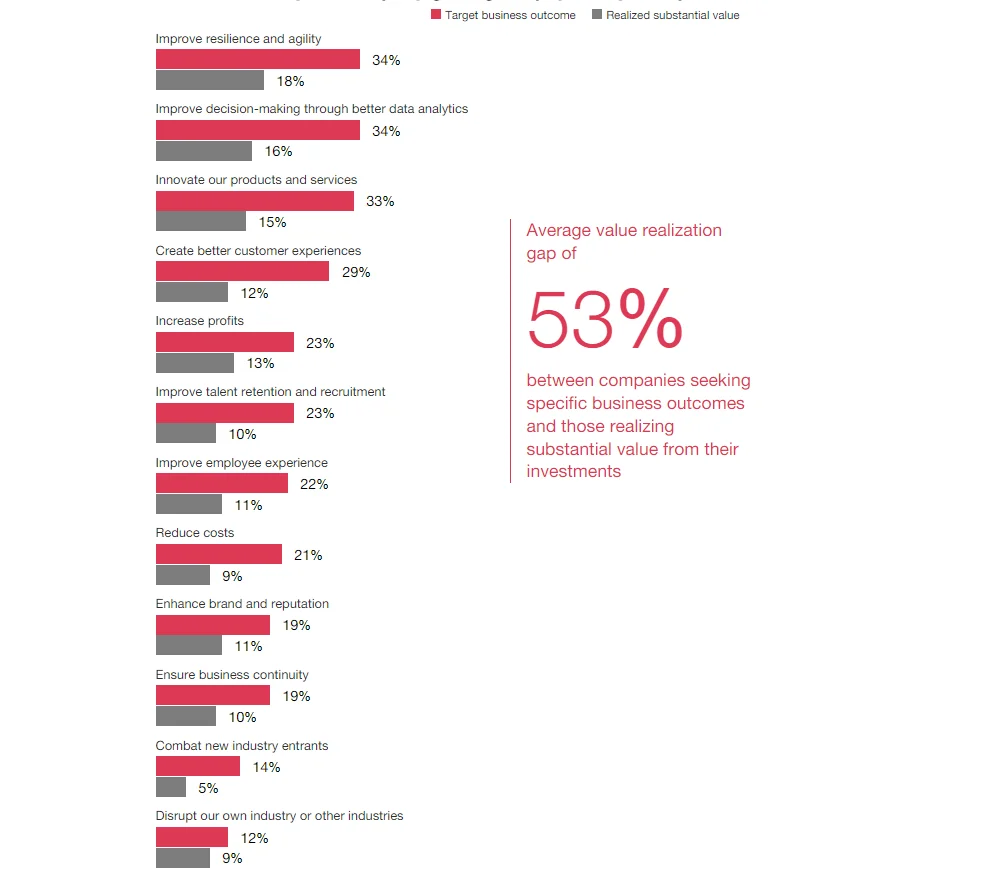
Credit: How valuable is cloud computing to companies – PwC research
The truth is that this is the case for many organizations — and for many that have moved to the cloud in order to optimize costs, it can be aggravating.
7. About 33% say they struggle to get engineering to take cloud cost optimization action (source: FinOps Foundation)
In most organizations, managing cloud costs is a top priority for their FinOps program. According to 30% of respondents in 2022 and nearly 33% in 2023, they’ve had trouble getting engineers on board and optimizing costs in the cloud.
FinOps Adoption and Growth Statistics
FinOps is gaining traction. Here’s how and why.
8. Only 13% of respondents have a mature FinOps program (source: FinOps Foundation)
The State of FinOps survey had some interesting findings regarding FinOps maturity levels;
- 7.5% of cloud FinOps practitioners were in the “pre-crawl” level
- 37.1% said they were still figuring out FinOps in the “crawl” stage
- 42.8% of practitioners were at the “walk” stage, meaning they had established their practice but were yet to perfect it
- 12.6% of respondents were at the “run” stage, where cloud FinOps is part of daily operations and culture.
There’s more.
9. Nearly half of respondents are not sure about FinOps in practice (source: CloudBolt)
A staggering 45% of executives and DevOps professionals said they considered FinOps:
- A necessary evil (7%)
- Nothing more than a suggested framework (10%)
- Much ado about nothing (13%)
- Easy in theory but harder in practice (15%)
In addition, 94% of respondents said they were playing the long game and considered FinOps a long-term investment.
According to the survey, 82% of organizations now have a formal FinOps team. Nearly half of those (44%) were formed in the past year. Another 16% say they are considering forming one.
10. 53% of cloud professionals are not sure engineering cares about cloud costs (source: CloudZero)
Only about half (47%) of the respondents in the State of Cloud Cost Intelligence survey said their engineering team had a strong culture of cost ownership. About 23% are adamant that engineering does not, 24% say sometimes engineering takes ownership of cloud costs, and 55 said they did not know.
Yet, engineers who are accountable for cloud costs have an improved understanding of their cloud spend.
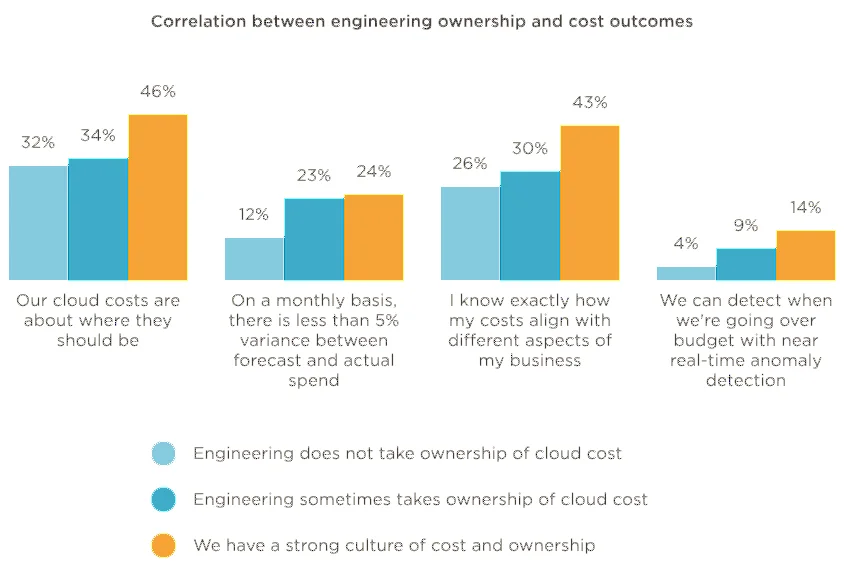
Statistics on Immediate FinOps Priorities for Practitioners
Over the next year, FinOps professionals will focus on several key priorities to maximize cloud ROI.
11. 96% acknowledge FinOps is important to their cloud strategy (source: Wakefield Research)
But only 9% have a mature FinOps practice, according to the 2023 State of Cloud Ops survey. Another 92% said they struggle with FinOps, in particular managing and reducing cloud costs (50%) and forecasting their cloud spend (47%).
Spot also found that 13% of respondents didn’t practice FinOps at all:
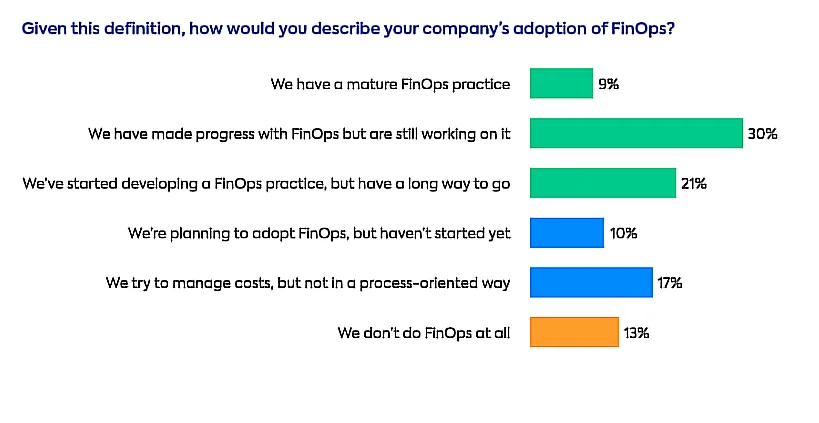
Credit: FinOps adoption – Spot
12. Budgeting, reducing waste, and improving cloud cost reporting are top priorities over the next 12 months (source: CloudZero)
The 1,000-respondent survey also found that cloud cost is a C-Suite and board-level issue now. These leaders are championing a raft of priorities over the next 12 months to maximize the value of the cloud to their organizations.
Consider this:
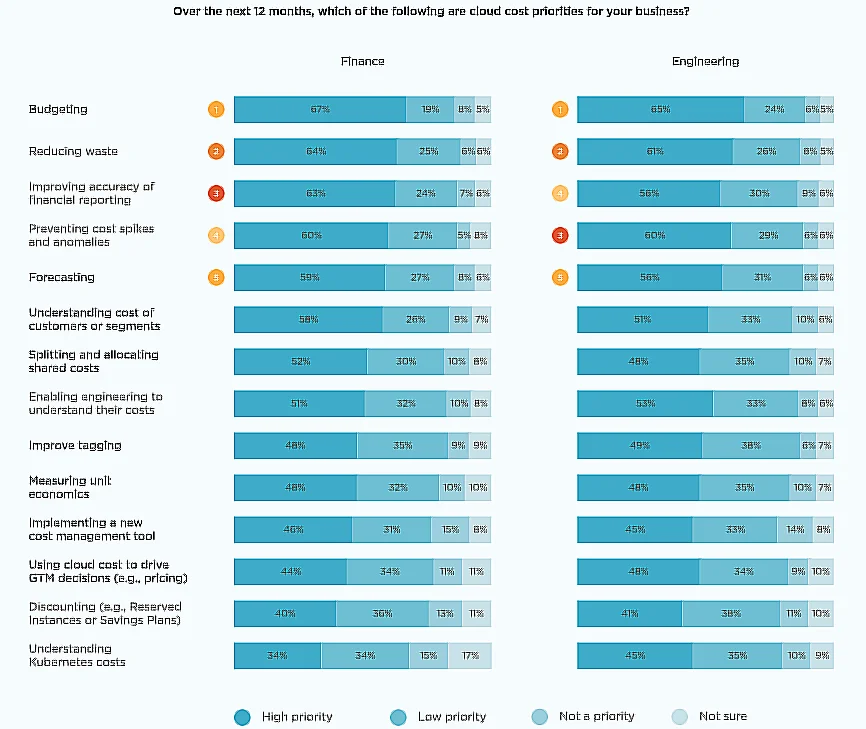
13. FinOps priorities are continuously evolving (Source: FinOps Foundation)
Cost allocation, establishing FinOps cultures, and rightsizing/resource utilization are the top three priorities for FinOps practitioners in 2023. Over the past year, measuring unit cost and integrating finance has also become more important, while empowering engineers to take cloud cost control remains the top challenge.
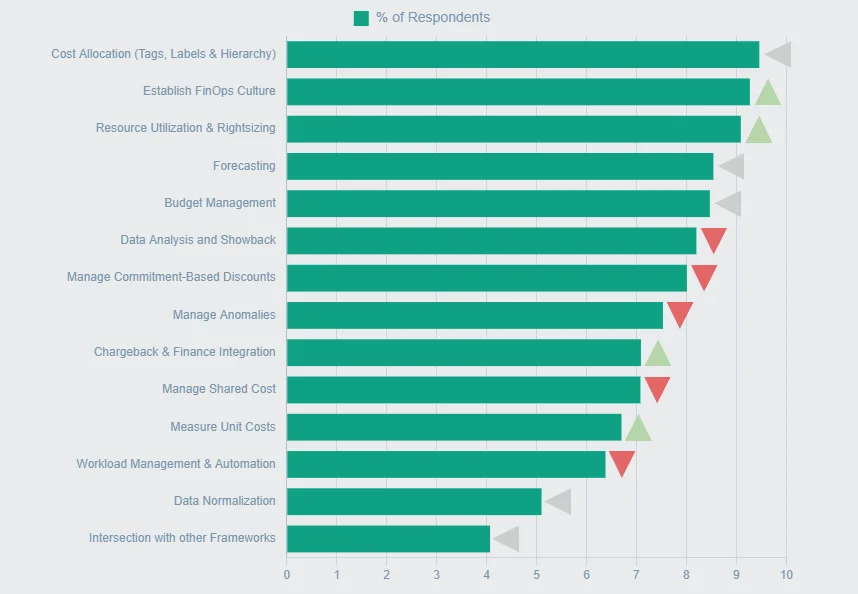
Credit: Top FinOps priorities according to the State of FinOps 2023
Stats On Measuring Cloud ROI
The struggle to make sense of cloud ROI is real. Here’s the deal.
14. Measuring cloud ROI can be elusive, but is achievable (source: PwC)
Picture this. For organizations seeking to improve their resilience and agility in 2023:
- 18% reported that they achieved “substantial value” from deploying in the cloud
- 16% reported improved decision-making
- 15% reported seeing innovation in their products and services.
Among those seeking to reduce cloud costs and safeguard business continuity:
- 9% and 10%, respectively, saw significant returns
- The cloud enabled 12% of companies to improve customer experiences.
However, PwC also reported significant inconsistencies in how executives define and quantify the value of their cloud investments.
- 39% of CIOs used “innovation” to measure the cloud’s value
- 23% assessed it in terms of improved operational resilience, safety, and soundness
- 7% regard revenue as a key value indicator
Surprisingly, 48% of CFOs said they lacked confidence in their ability to measure cloud ROI.
15. It takes 1-3 years to pay back cloud investment (source: McKinsey)
A McKinsey survey reported that companies may not realize the full benefits of cloud computing right away. By implementing cloud computing best practices, organizations can expect to see substantial benefits within 1-3 years.
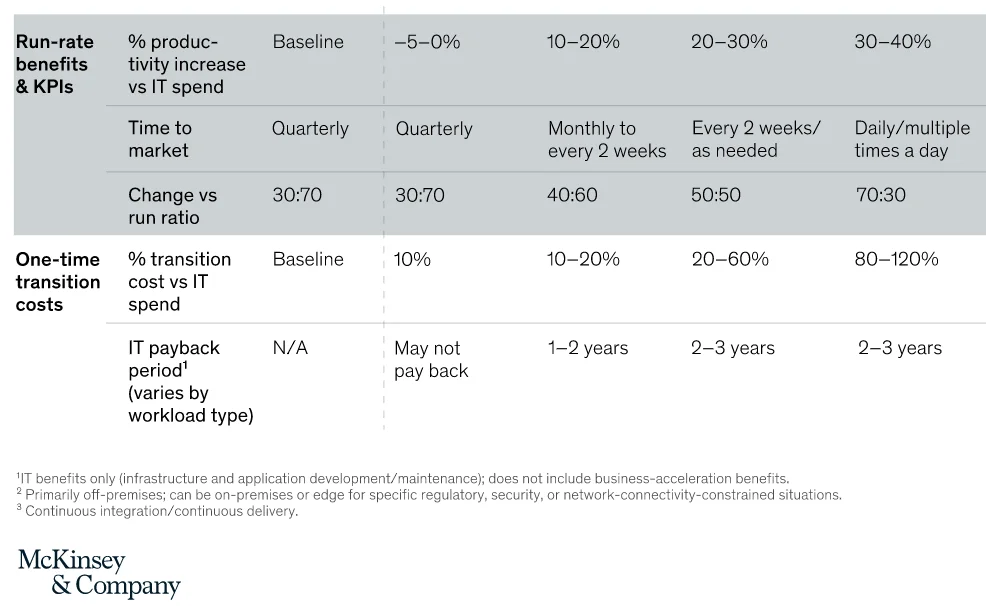
Credit: McKinsey
Latest Statistics On FinOps Challenges
As with any other initiative, implementing FinOps has its fair share of challenges. We’ve compiled a guide on some of the top 9 FinOps challenges today, and tips for how to solve them. And now here is what else is happening right now.
16. Getting engineers to take action on cloud costs is the biggest challenge (source: FinOps Foundation)
In 2022, getting engineers to reign in cloud costs was the biggest challenge for FinOps professionals. Accurate cloud cost forecasting, adopting FinOps organization-wide, and enabling automation rounded up the top four FinOps challenges that year.
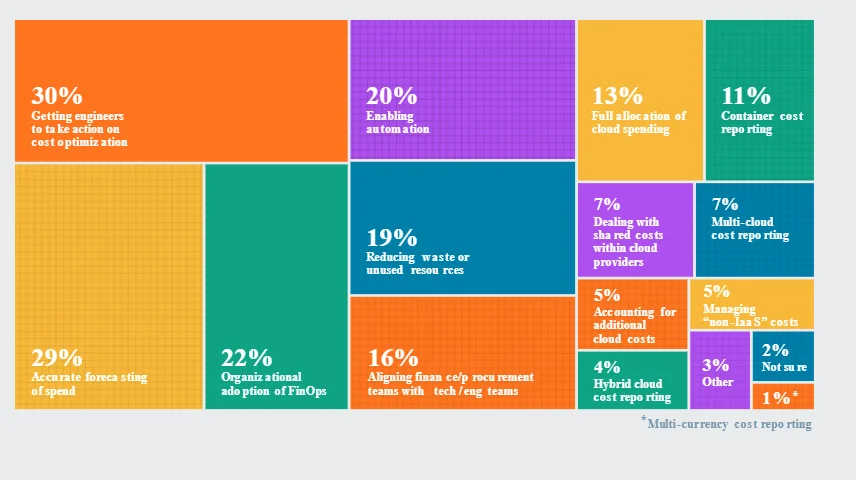
In 2023, helping engineering to control cloud costs is still the main challenge.
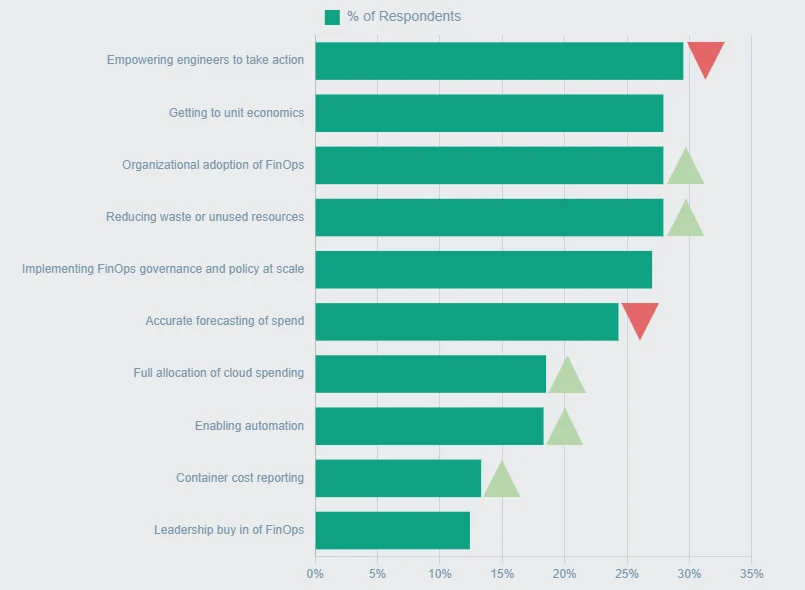
This may indicate that organizations are having difficulties providing engineers with the information they need to make informed decisions about cloud costs. Cloud cost optimization, for example, is not well shared with engineers, but rather is a function of finance departments in many organizations.
17. 5 years on and managing cloud spend is still the top challenge (source: Flexera)
A majority of cloud professionals say managing cloud costs effectively is their biggest challenge for the fifth consecutive year. In fact, FinOps is a bigger challenge than cloud security or multi-cloud management.
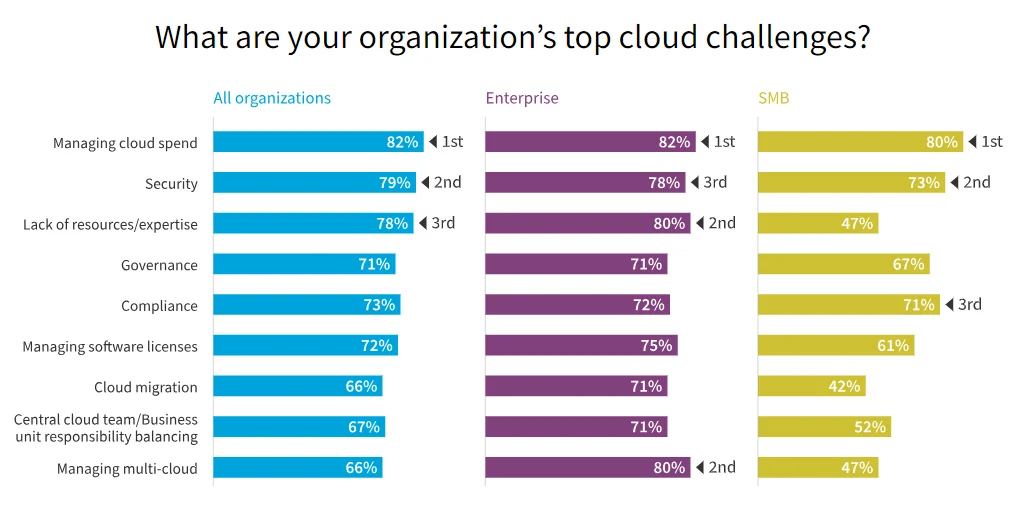
The challenges are leading 71% of cloud financial management teams to doubt their ability to deliver the expected results within the expected timeframe, according to Accenture’s Cloud Outcomes Research.
In addition, CloudZero’s survey found 55% of engineers spend significant time each week dealing with cloud costs issues. Cost spikes and discrepancies between forecasts and actual spending were among these challenges. Cost issues caused disruptions that lasted at least one sprint for 11% of respondents.
18. The top challenge for CIOs and CTOs is cloud waste, according to 42% (source: Zesty)
Resource management is a problem for 42% of CIOs and CTOs. In most cases, waste results from overprovisioning and an inability to scale down rapidly. As a result, cloud service allocations increased by 67% annually in 2022.
A further 58% of respondents said finding the right cloud cost management solution for their workload was the most challenging part of managing cloud costs. And speaking of cloud cost optimization solutions, here’s what’s happening there.
Statistics on FinOps Tools and Technologies
FinOps professionals heavily rely on native cloud provider tools to handle cloud cost visibility, analysis, forecasting, allocation, and optimization. Think about this.
19. 310 out of 350 use AWS Cost Explorer (source: FinOps Foundation)
Most respondents said they still used the native AWS cost tool as their primary solution (103), frequently (132), and occasionally (70). Overall, 78% used Cost Explorer, 48% used Azure cost management, 27% used GCP native tools, and 26% used a homegrown tool.
That makes sense, given how many professionals have difficulty allocating cloud spending and managing costs.
Here’s the thing. Native tools are useful for small workloads and casual use, but robust cloud cost platforms are recommended for larger applications, and more importantly, if you want to get more detailed and actionable cloud cost insights, such as unit costs.
Consequently, only 3 out of 10 know exactly where their cloud spend is going.
20. Visibility into detailed cloud usage and associated costs hinders effective FinOps (source: CloudZero)
Larger companies are the most affected.
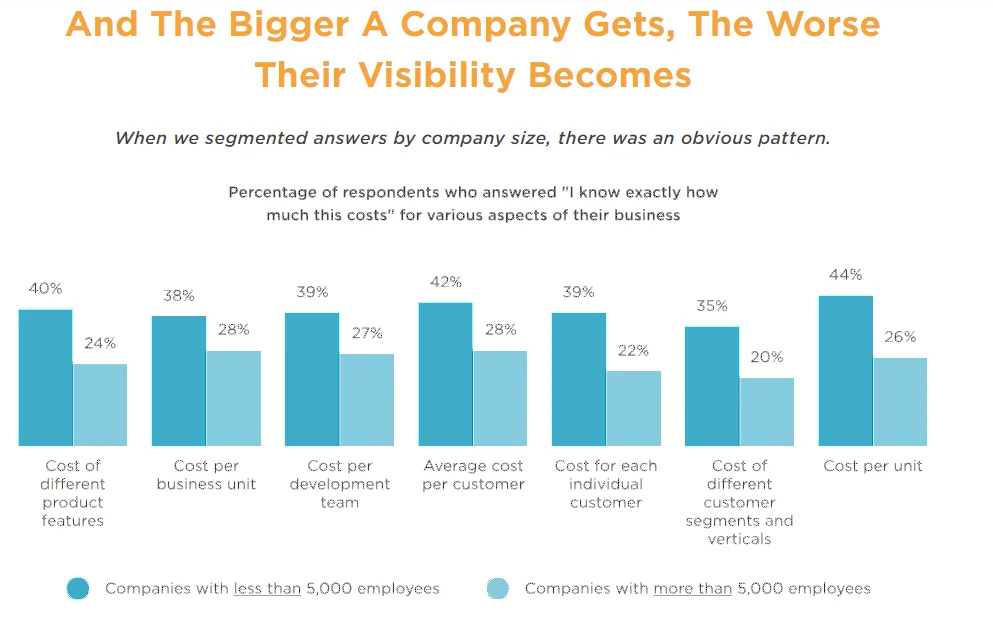
Most cost tools are inexact, clunky, and manual. Yet, you need a platform that connects cost data to your business applications (people, products, and processes). This way, you’ll know who, what, and why your costs are changing – and actually be able to do something about it.
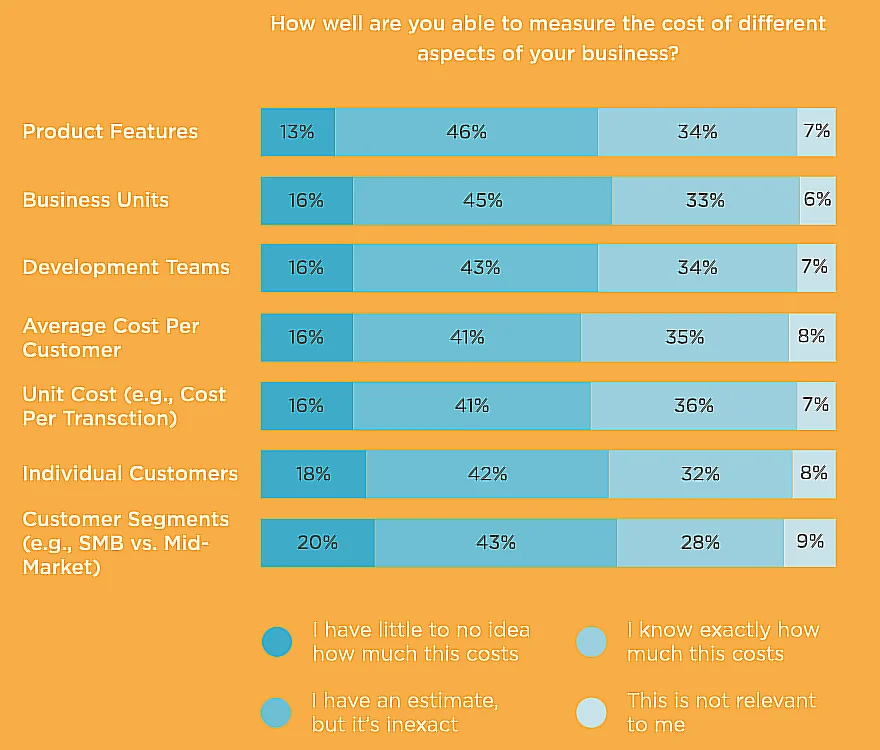
The good news is that CloudZero’s all-in-one cloud cost intelligence allows you to break down your cloud spend into unit costs, such as cost per customer, product, feature, project, team, and environment.
And, unlike the 34% of practitioners who only see or share cloud cost data monthly, CloudZero delivers actionable insights hourly so you can prevent overspending sooner. Take a product tour of CloudZero here for yourself to see if you agree.
21. 82% of respondents use automation to optimize cloud costs (source: NetApp)
The 2023 State of CloudOps report shows that 70% have deployed commercial, open-source, or custom cloud cost management solutions. Another 82% believe automation is “critical” or “very valuable” for maximizing cloud ROI and optimizing cloud operations.
The Future Of FinOps and Current Trends
FinOps is a bubbling cloud financial management discipline — and the data backs it up. The current trends in FinOps include measuring unit costs, calculating cloud ROI, and accurately allocating and forecasting cloud spend.
To achieve this, many respondents said they are shifting cloud cost management left; empowering engineering to understand and control cloud costs in alignment with in-house finance and operations teams.
22. 65% see FinOps in their future (source: FinOps Foundation)
While 29% are not sure, only 5% of FinOps practitioners said they do not see FinOps as part of their career path going forward. In organizations where FinOps is mature (“Running” level), they said FinOps is their primary role 41% of the time.
Something else. Each year, the size of the average FinOps team varies. Many respondents are also sole FinOps players. This suggests many teams are still at the beginning of their FinOps journeys – and they have a lot of room for growth.
23. 30% will need to master shared and untagged costs in the cloud (source: FinOps Foundation and CloudZero)
Three out of 10 respondents do not split shared costs in any way, 46% use the proportional model, 32% by percentage, and 10% by even split (average cost per X). This area is set to improve to empower FinOps professionals to view accurate cost per tenant in multi-tenant architectures.
A few platforms, such as CloudZero (for multi-cloud and Kubernetes cloud costs) and Kubecost (Kubernetes cost analysis) already offer this.
CloudZero gives you a clearer picture of your cloud ROI in the language of FinOps. Our Cloud Cost Intelligence approach delivers:
- Unit cost by FinOps, engineering, and finance roles so you can tell who and what’s driving your costs — and why
- Hourly cost insights enable you to keep track of your burn rate — anytime, anywhere
- Real-time cost anomaly detection alerts you to trending costs via Slack so you can prevent overspending
- Understand your Cost of Goods Sold (COGS) and gross margin on demand
- Allocate 100% of your cloud spend with confidence
- Robust budgeting and forecast helps prevent a surprise bill
Drift saved $4 million in annual AWS costs with CloudZero. MalwareBytes 10 hours per week managing cloud costs. Remitly allocates 50% more cloud costs. Validity also spends 90% less time managing costs. You can do it, too.  to see why these brands prefer CloudZero.
to see why these brands prefer CloudZero.








